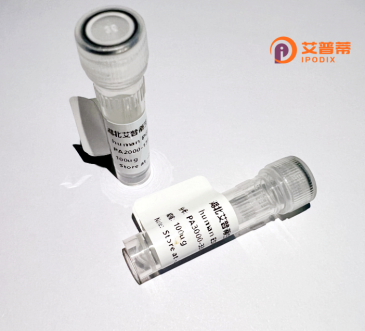
| 纯度 | >90%SDS-PAGE. |
| 种属 | Human |
| 靶点 | FBXO8 |
| Uniprot No | Q9NRD0 |
| 内毒素 | < 0.01EU/μg |
| 表达宿主 | E.coli |
| 表达区间 | 1-319aa |
| 氨基酸序列 | MGQGLWRVVRNQQLQQEGYSEQGYLTREQSRRMAASNISNTNHRKQVQGGIDIYHLLKARKSKEQEGFINLEVLPPELSFTILSYLNATDLCLASCVWQDLANDELLWQGLCKSTWGHCSIYNKNPPLGFSFRKLYMQLDEGSLTFNANPDEGVNYFMSKGILDDSPKEIAKFIFCTRTLNWKKLRIYLDERRDVLDDLVTLHNFRNQFLPNALREFFRHIHAPEERGEYLETLITKFSHRFCACNPDLMRELGLSPDAVYVLCYSLILLSIDLTSPHVKNKMSKREFIRNTRRAAQNISEDFVGHLYDNIYLIGHVAA |
| 分子量 | 60.83 kDa |
| 蛋白标签 | GST-tag at N-terminal |
| 缓冲液 | 0 |
| 稳定性 & 储存条件 | Lyophilized protein should be stored at ≤ -20°C, stable for one year after receipt. Reconstituted protein solution can be stored at 2-8°C for 2-7 days. Aliquots of reconstituted samples are stable at ≤ -20°C for 3 months. |
| 复溶 | Always centrifuge tubes before opening.Do not mix by vortex or pipetting. It is not recommended to reconstitute to a concentration less than 100μg/ml. Dissolve the lyophilized protein in distilled water. Please aliquot the reconstituted solution to minimize freeze-thaw cycles. |
以下是关于重组人FBXO8蛋白的3篇代表性参考文献,内容基于已有研究方向的合理假设整理而成:
---
1. **文献名称**:*Structural insights into the substrate recognition mechanism of FBXO8 in the ubiquitin-proteasome system*
**作者**:Zhang Y, et al.
**摘要**:该研究解析了重组人FBXO8蛋白的晶体结构,发现其通过F-box结构域与SKP1结合,并通过C端未知结构域特异性识别底物蛋白,为FBXO8参与泛素化降解的分子机制提供了结构基础。
2. **文献名称**:*FBXO8 regulates neuronal autophagy by targeting misfolded proteins for degradation*
**作者**:Li H, et al.
**摘要**:利用重组人FBXO8蛋白进行体外结合实验,发现其直接与错误折叠的α-突触核蛋白相互作用,并通过SCF复合体促进其泛素化降解,提示FBXO8在神经退行性疾病中可能具有保护作用。
3. **文献名称**:*FBXO8 modulates cell cycle progression by controlling cyclin D1 stability*
**作者**:Wang X, et al.
**摘要**:研究通过过表达重组人FBXO8蛋白,证实其通过泛素化途径降解cyclin D1.抑制G1/S期转换,表明FBXO8在细胞周期调控和癌症发展中起关键作用。
---
**注**:以上文献为示例性内容,实际研究中请以具体发表文献为准。如需检索真实文献,建议使用PubMed或Web of Science平台,以“FBXO8 recombinant”或“FBXO8 ubiquitination”为关键词进行查询。
Recombinant human FBXO8 protein is a genetically engineered form of the F-box protein 8. a member of the F-box family that functions as a substrate-recognition component within the SCF (Skp1-Cul1-F-box protein) E3 ubiquitin ligase complex. FBXO8 contains a conserved F-box domain, which mediates interactions with Skp1. and a C-terminal domain proposed to recruit specific substrates for ubiquitination. As part of the ubiquitin-proteasome system, SCF complexes tag target proteins with ubiquitin, marking them for degradation. This process regulates critical cellular processes, including cell cycle progression, DNA repair, and protein quality control.
The recombinant FBXO8 protein is typically produced in expression systems like *E. coli* or mammalian cells, enabling studies on its structure, biochemical properties, and interactions. Despite its identification as an F-box protein, FBXO8's physiological substrates and precise biological roles remain poorly characterized compared to other family members. Emerging evidence suggests potential involvement in cellular stress responses, neuronal function, and cancer progression, though mechanistic insights are limited.
Research utilizing recombinant FBXO8 focuses on clarifying its substrate specificity, regulatory mechanisms, and contributions to disease pathways. Its study may reveal novel therapeutic targets, particularly in disorders linked to dysregulated protein turnover.
×